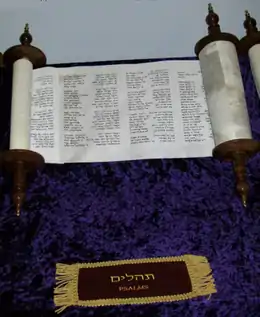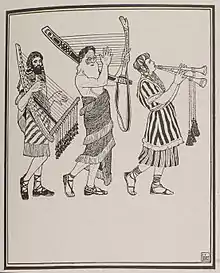Psalm 34
Psalm 34 is the 34th psalm[1][2][3][4][5] of the Book of Psalms, or Psalm 33 according to the Greek numbering system. It is an acrostic poem in the Hebrew Alphabet, one of a series of the songs of thanksgiving. It is the first Psalm which describes angels as guardians of the righteous.

Psalm 34 attributes its own authorship to David. The Psalm's sub-title, A Psalm of David when he pretended madness before Abimelech, who drove him away, and he departed,[6] derives from when David was living with the Philistines, but the account of this event in 1 Samuel 21 refers to the king as Achish, not Abimelech.[7]
Structure

The psalm could be structured in the following manner:[8]
- Vers 2-4: Hymn Introduction
- Vers 5: Basic praising, preaching the fate of the Psalmist
- Vers 6-11: teaching, which is evident from his fate
- Vers 12-22: didactic poem 1.Vers 12: psalmist is now "teacher"
- Vers 13-15: Question - Answer:
- Vers 16-22
- Collection of wise sayings
It is an acrostic poem in the Hebrew Alphabet, with each letter of the Hebrew alphabet beginning a verse in sequential order; the lone exception is waw ( ו ), which begins the second clause of verse six. Verse 22, the concluding statement, begins with pe, outside the acrostic scheme. The Old Testament scholar Hermann Gunkel felt that the acrostic nature of the Psalm made any historical, or theological analysis impossible.[9] This psalm is an acrostic of confidence as is Psalm 25 with which it has many similarities.
Uses

Judaism
- Is recited in its entirety during Pesukei Dezimra on Shabbat, Yom Tov, and Hoshana Rabbah.[10]
- Verse 4 is recited when the Torah scroll is taken out of the ark.[11]
- Verses 10-11 are part of the final paragraph of Birkat Hamazon.[12]
- Verses 14-15 form the basis for part of the closing paragraph of the Amidah.[13]
New Testament
Some verses of Psalm 34 are referenced in the New Testament:
Catholicism
According to the Rule of St. Benedict around 530,[16] this psalm was traditionally performed at the office of Matins Monday with monasteries.[17][18]
Currently, in the Liturgy of the Hours, Psalm 34 is recited Saturday from the first and third weeks and for the holy celebrations, the median time. It is often taken to church as a responsorial psalm.[19]
Musical Settings
Verse 8 is set to music by Vaughan Williams, entitled "O taste and see".[20]
References
- Commentaires sur les psaumes, d’Hilaire de Poitiers, (Paris, Éditions du Cerf, 2008), collection sources chrétiennes n°515,
- Commentaires sur les psaumes, de Jean Chrysostome, ive siècle,
- Discourse of the Psalmes, by Saint Augustin, vol.2,(Sagesses chrétiennes)
- Commentairy (jusqu’au psaume 54), by saint Thomas Aquinas, (Éditions du Cerf, 1273)
- Jean Calvin, Commentaire des psalmes, 1557
- Sub-title, NKJV Version
- 1 Samuel 21:10–15
- Corinne Lanoir in Römer, Macchi et Nihan 2009, p. 346.
- Herman Gunkel, Die Psalmen, (61986), 142f.
- The Complete Artscroll Siddur page 376
- The Complete Artscroll Siddur page 141
- The Complete Artscroll Siddur page 195
- The Complete Artscroll Siddur page 119
- Kirkpatrick, A. F. (1901). The Book of Psalms: with Introduction and Notes. The Cambridge Bible for Schools and Colleges. Book IV and V: Psalms XC-CL. Cambridge: At the University Press. p. 838. Retrieved February 28, 2019.
- Nolland, John. The Gospel of Matthew: a commentary on the Greek text. Wm. B. Eerdmans Publishing, 2005 pg. 199
- Règle de saint Benoît, traduction de Prosper Guéranger, (Abbaye Saint-Pierre de Solesmes, réimpression 2007) p46.
- Psautier latin-français du bréviaire monastique,(1938/2003)p. 137,
- La distribution des Psaumes dans la Règle de Saint Benoît.
- The main cycle of liturgical prayers takes place over four weeks.
- "O Taste and See (Vaughan Williams, Ralph)". IMSLP. Retrieved 29 May 2020.
External links
| Wikimedia Commons has media related to Psalm 34. |
- Psalm 34 in Hebrew and English - Mechon-mamre
- Psalm 34 King James Bible - Wikisource
- Recording of a slow tune to verses 12-14.